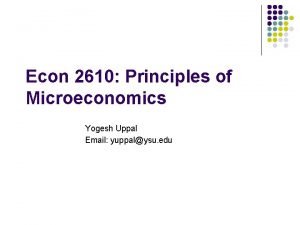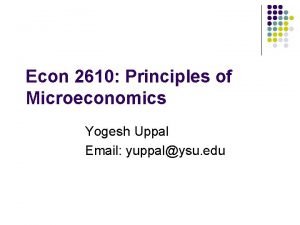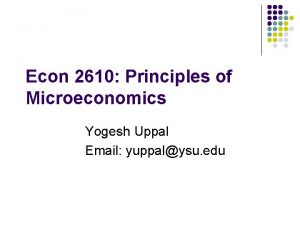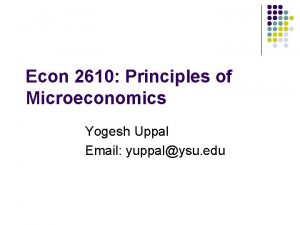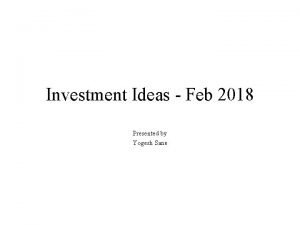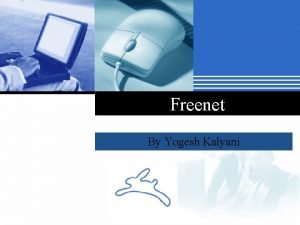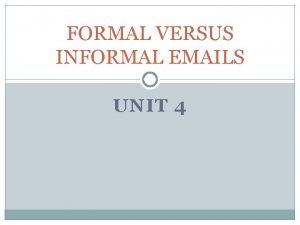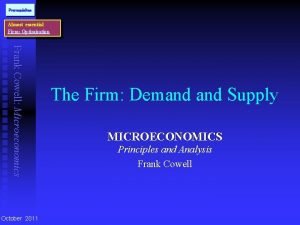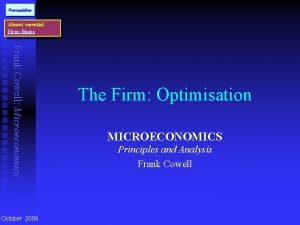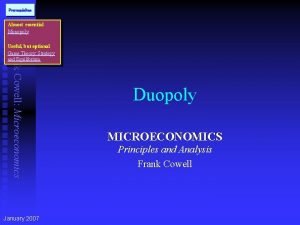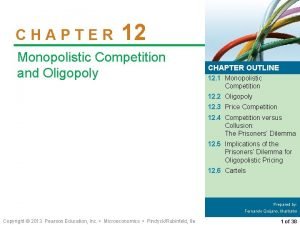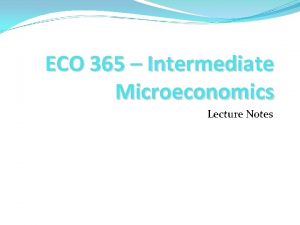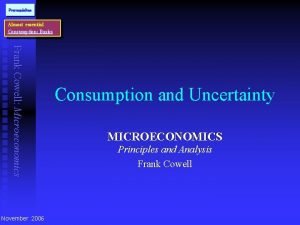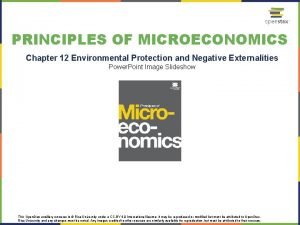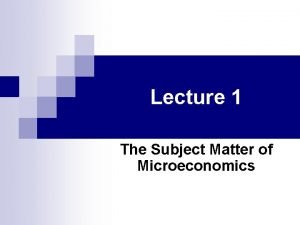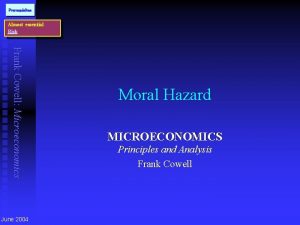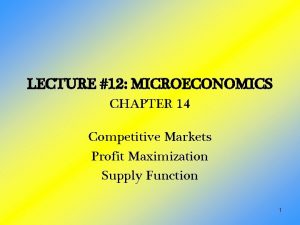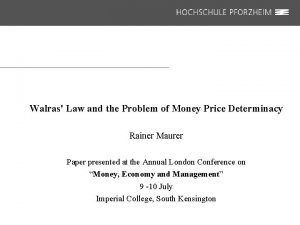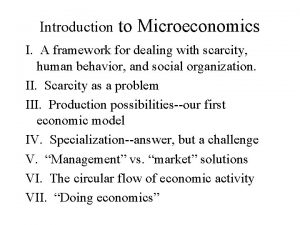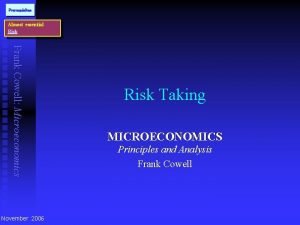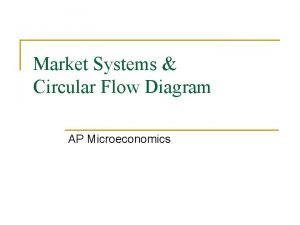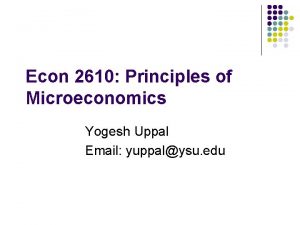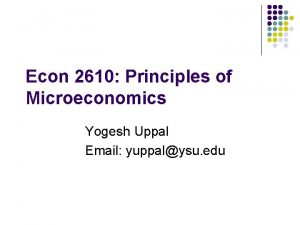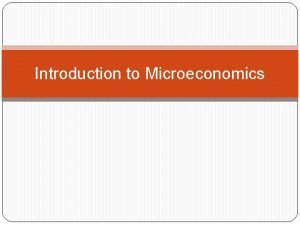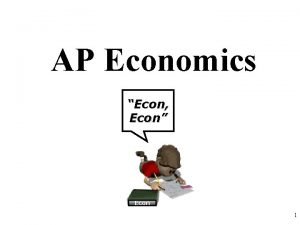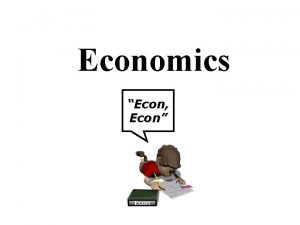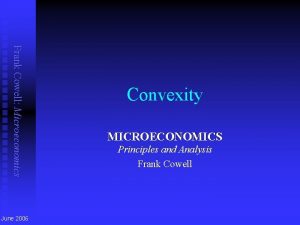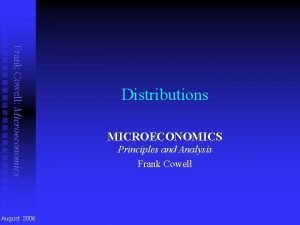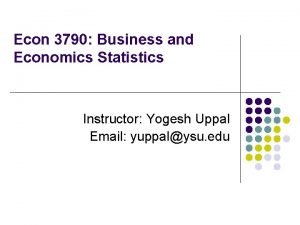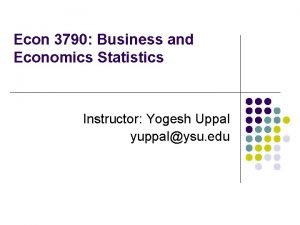Econ 2610 Principles of Microeconomics Yogesh Uppal Email





























- Slides: 29

Econ 2610: Principles of Microeconomics Yogesh Uppal Email: yuppal@ysu. edu

Chapter 2 Comparative Advantage Mc. Graw-Hill/Irwin 2 -2 © The Mc. Graw-Hill Companies, Inc. , 2009

Learning Objectives 1. 2. 3. 4. 5. The Principle of Comparative Advantage The Principle of Increasing Opportunity Cost Factors that shift the menu of production possibilities The role of comparative advantage in international trade Why some jobs are more vulnerable to outsourcing than others Mc. Graw-Hill/Irwin 2 -3 © The Mc. Graw-Hill Companies, Inc. , 2009

Do It Yourself? l Joe, a highly successful trial attorney, employs another attorney to write his will l l Writing your own will Opportunity cost of 2 hours Hiring someone to spend 4 hours on your will Making the right economic choice Do It Yourself only when Opportunity cost < hired cost Mc. Graw-Hill/Irwin 2 hours $10, 000+ $3, 200 Priceless 2 -4 © The Mc. Graw-Hill Companies, Inc. , 2009

Production Advantages l Definitions l Absolute advantage § l Comparative advantage § l Lowest production cost Lower opportunity cost than someone else The principle of comparative advantage § Mc. Graw-Hill/Irwin Every one does best when each concentrates on activity with the lowest opportunity cost 2 -5 © The Mc. Graw-Hill Companies, Inc. , 2009

The Principle of Comparative Advantage l Two parties have different opportunity costs for two activities l l Concentrate on the activities of your lowest opportunity cost Total value of output increases with specialization and trade Mc. Graw-Hill/Irwin 2 -6 © The Mc. Graw-Hill Companies, Inc. , 2009

Comparative Advantage Example Production Times Paula Beth l Web Update Bike Repair 20 minutes 30 minutes 10 minutes 30 minutes Paula and Beth can each update web pages and repair bikes l Paula has an absolute advantage in both Mc. Graw-Hill/Irwin 2 -7 © The Mc. Graw-Hill Companies, Inc. , 2009

Comparative Advantage Example Production Times Paula Beth Opportunity Cost Paula Beth Mc. Graw-Hill/Irwin Web Update Bike Repair 20 minutes 30 minutes 10 minutes 30 minutes Web Update Bike Repair 2 repairs 1 repair 0. 5 update 1 update 2 -8 © The Mc. Graw-Hill Companies, Inc. , 2009

Comparative Advantage Example Production Times Paula Beth Web Update Bike Repair 20 minutes 30 minutes 10 minutes 30 minutes Hourly Output Web Update Bike Repair Paula 3 updates 6 repairs Beth 2 updates 2 repairs Mc. Graw-Hill/Irwin 2 -9 © The Mc. Graw-Hill Companies, Inc. , 2009

Comparative Advantage Example Hourly Output Paula Beth l Bike Repair 6 repairs 2 repairs 16 web updates are ordered l l Web Update 3 updates 2 updates Paula spends half her time at each activity: 12 updates and 24 repairs Beth produces 4 updates and 12 repairs Total output 16 updates and 36 repairs Specialization produces 16 updates and 48 repairs 2 -10 12 more repairs for the same inputs! Mc. Graw-Hill/Irwin © The Mc. Graw-Hill Companies, Inc. , 2009 l

Another Example Hourly Output Pat Barb Bike Repair 2 updates 1 repair 3 updates 3 repairs l Principle of Comparative Advantage is the same l Look at opportunity cost per unit l Pat updates web pages and Barb repairs bikes Opportunity Web Update Bike Repair Cost Pat ½ repair 2 updates Barb 1 repair 1 update Mc. Graw-Hill/Irwin Web Update 2 -11 © The Mc. Graw-Hill Companies, Inc. , 2009

Sources of Comparative Advantage l l l Talent Natural resources Cultures or societal norms l l Languages Institutions l l Value placed on craftsmanship Support for entrepreneurship Mc. Graw-Hill/Irwin 2 -12 © The Mc. Graw-Hill Companies, Inc. , 2009

Production Possibilities Curve l A graph of the combinations of two goods that can be produced with given resources 24 A Definitions Unattainable l l Unattainable point Attainable point l l l Inefficient point Efficient point Scarcity Principle l Give up one good to get another Mc. Graw-Hill/Irwin Combination Coffee (lb/day) l 16 8 B Inefficient Combination C D 4 8 12 Nuts (lb/day) 2 -13 © The Mc. Graw-Hill Companies, Inc. , 2009

Susan's Production Possibilities Two goods: coffee and nuts l l Work 6 hours per day 1 hour of labor = 4 pounds of coffee OR = 2 pounds of nuts l Graph shows options l Negative slope, which is constant Mc. Graw-Hill/Irwin 24 Coffee (lb/day) l 16 8 A B C D 4 8 12 Nuts (lb/day) 2 -14 © The Mc. Graw-Hill Companies, Inc. , 2009

Susan's Opportunity Cost l Opportunity cost of 1 nut is 2 coffee l Opportunity cost of 1 coffee is ½ nut Coffee (lb/day) 24 A B 16 C 8 4 8 D 12 Nuts (lb/day) Mc. Graw-Hill/Irwin 2 -15 © The Mc. Graw-Hill Companies, Inc. , 2009

Tom's Production Possibilities Work 6 hours per day l 1 hour of labor = 4 pounds of nuts OR = 2 pounds of coffee l l Tom's opportunity cost of 1 coffee is 2 nuts His opportunity cost of 1 nut is ½ coffee 12 Coffee (lb/day) l A B 8 C 4 D 8 16 24 Nuts (lb/day) Mc. Graw-Hill/Irwin 2 -16 © The Mc. Graw-Hill Companies, Inc. , 2009

Tom, Meet Susan PPCs show comparative advantage l Sue's curve is steeper, better for coffee l Tom's curve is flatter, better for nuts 24 Coffee (lb/day) l Susan’s PPC 12 Tom’s PPC 12 Nuts (lb/day) Mc. Graw-Hill/Irwin 24 2 -17 © The Mc. Graw-Hill Companies, Inc. , 2009

Tom, Meet Susan l l To get 1 coffee, Sue gives up ½ nuts and Tom gives up 2 nuts To get 1 nut, Sue gives up 2 coffees and Tom ½ coffee. Sue has CA in coffee and Tom in production of nuts. 24 Coffee (lb/day) l Susan’s PPC 12 Tom’s PPC 12 Nuts (lb/day) 24

Gains from Specialization and Trade l Without trade, each person can consume along his production possibilities curve l l What you produce determines what you consume With trade, each person's consumption can be greater than production l l Produce according to comparative advantage Trade to get what you want Mc. Graw-Hill/Irwin 2 -19 © The Mc. Graw-Hill Companies, Inc. , 2009

Gains from Specialization and Trade Coffee (lb/day) 24 Suppose preferred diet equal amount of coffee and nuts l No trade: 8 pounds of coffee and 8 pounds of nuts l Total output is 32 pounds Susan and Tom exchange 12 nuts, 12 coffee 12 8 8 12 Nuts (lb/day) Mc. Graw-Hill/Irwin l 24 2 -20 © The Mc. Graw-Hill Companies, Inc. , 2009

Gains from Specialization and Trade Specialization gives each person 12 pounds of each good → 48 total pounds Coffee (lb/day) 24 Susan and Tom exchange 12 nuts, 12 coffee 12 8 8 12 Nuts (lb/day) 24 l Benefits increase when differences in opportunity cost increase

Production Possibilities for an Economy l l Two goods: coffee and nuts Increasing opportunity cost, given by the slope of PPC. Some resources better at coffee, some better at nuts Coffee (1000 s of lb/day) l 100 95 90 A B C D 20 15 E 20 30 Nuts (1000 s of lb/day) Mc. Graw-Hill/Irwin 75 80 77 2 -22 © The Mc. Graw-Hill Companies, Inc. , 2009

The Principle of Increasing Opportunity Cost Maximum coffee: 100, 000 lb / day l Give up 5, 000 pounds coffee, get 20, 000 pounds of nuts l Give up another 5, 000 pounds of coffee, get an 10, 000 additional pounds of nuts Coffee (1000 s of lb/day) l 100 95 90 A B C D 20 15 E 20 30 Nuts (1000 s of lb/day) Mc. Graw-Hill/Irwin 75 80 77 2 -23 © The Mc. Graw-Hill Companies, Inc. , 2009

Re sou rce s. U sed Start with resources with lowest opportunity cost Mc. Graw-Hill/Irwin Then move to next highest opportunity cost And still higher opportunity cost Decreasing productivity The Principle of Increasing Opportunity Cost 2 -24 © The Mc. Graw-Hill Companies, Inc. , 2009

The Dynamic Economy l A PPC represents current choices l Changes in choices occur over time due to l More resources § § l Improvements in technology § l Investment in capital Population growth More specialization: start-up and switching costs Increases in knowledge Mc. Graw-Hill/Irwin 2 -25 © The Mc. Graw-Hill Companies, Inc. , 2009

Shifts in PPC Neutral Technical Change Coffee Technical Change in Coffee Nuts Coffee Technical Change in Nuts Mc. Graw-Hill/Irwin 2 -26 © The Mc. Graw-Hill Companies, Inc. , 2009

Some Countries Resist Specialization l Specialization is easier when l l Population density passes a threshold Markets are connected l l Transportation for goods Communications for services Legal framework supports business Financial markets enable start-ups Mc. Graw-Hill/Irwin 2 -27 © The Mc. Graw-Hill Companies, Inc. , 2009

Comparative Advantage and International Trade l Principle of Comparative Advantage and gains from trade apply worldwide l l Potentially large gains from trading with different and distant countries Controversial trade l l Benefits the society broadly Costs are concentrated l l l Some industries People who lose their jobs e. g. , outsourcing, loss of manufacturing etc. Mc. Graw-Hill/Irwin 2 -28 © The Mc. Graw-Hill Companies, Inc. , 2009

Comparative Advantage Increasing Opportunity Cost Specialization and Gains from Trade Production Possibilities Curve Individual Outsourcing Shift PPC Economy Mc. Graw-Hill/Irwin 2 -29 © The Mc. Graw-Hill Companies, Inc. , 2009
 Yogesh uppal
Yogesh uppal Polluter
Polluter Yogesh uppal
Yogesh uppal Econ
Econ Yogesh sane
Yogesh sane Yogesh kalyani
Yogesh kalyani Pavan uppal
Pavan uppal 22 rents
22 rents Informal and formal email
Informal and formal email Objective of microeconomics
Objective of microeconomics Intermediate microeconomics lecture notes
Intermediate microeconomics lecture notes Frank cowell
Frank cowell Transfer payments
Transfer payments Frank cowell
Frank cowell Example of microeconomics
Example of microeconomics Cowell microeconomics
Cowell microeconomics Microeconomics examples
Microeconomics examples Microeconomics
Microeconomics Oligopoly model
Oligopoly model Intermediate microeconomics notes
Intermediate microeconomics notes Cowell microeconomics
Cowell microeconomics Microeconomics chapter 12
Microeconomics chapter 12 Macroeconomics michael parkin 13th edition
Macroeconomics michael parkin 13th edition What is the subject matter of microeconomics
What is the subject matter of microeconomics Almost essential
Almost essential Microeconomics
Microeconomics Walrus law
Walrus law Microeconomics ia
Microeconomics ia Cowell microeconomics
Cowell microeconomics Circular flow diagram menggambarkan
Circular flow diagram menggambarkan
